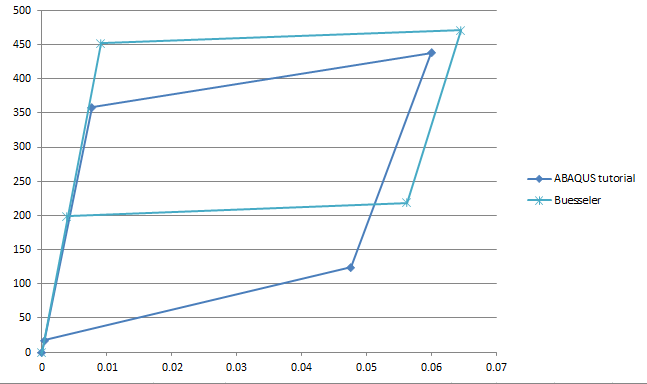I'm having some difficulty running a stent analysis and I'm hoping there might be some expertise here that can help me out. I just got done taking the online stent simulation tutorial from Simulia, and now I'm working to extrapolate on my own practice. I have a very simple laser-cut style 8- strut, single loope strut "stent" in 1/8 symmetry. It's nitinol, with an expand, recoil, and pressure steps. It fails about 0.73 through the expand step with time increments too small error. (general static step). I'm trying to define the nitinol with plasticity so I can overstrain it and model a good recoil behavior. My material model is as follows:
7232772.81
0.33
4403414.861
0.33
0.048987845
986.2584
65533.12968
68269.43497
0
986.2584
31662.44994
28827.94359
75637.317
0.0515
0
0
10
68312.898
0.065
90286.44508
0.06949
112303.6486
0.07449
156220.4298
0.08449
174045.6
0.09
184923.45
0.095
188549.4
0.1
190724.97
0.105
191450.16
0.11
192175.35
0.15
("units" are psi and C FWIW).
I've also tried eliminating the plasticity part and it still fails around the same time step. The max stress is only around 70 ksi, so it's still well within the material model. I've done "tricks" with nlgeom, and general solution controls I0, and Ir. I attached my cae file here.
Any thoughts why this won't converge?
7232772.81
0.33
4403414.861
0.33
0.048987845
986.2584
65533.12968
68269.43497
0
986.2584
31662.44994
28827.94359
75637.317
0.0515
0
0
10
68312.898
0.065
90286.44508
0.06949
112303.6486
0.07449
156220.4298
0.08449
174045.6
0.09
184923.45
0.095
188549.4
0.1
190724.97
0.105
191450.16
0.11
192175.35
0.15
("units" are psi and C FWIW).
I've also tried eliminating the plasticity part and it still fails around the same time step. The max stress is only around 70 ksi, so it's still well within the material model. I've done "tricks" with nlgeom, and general solution controls I0, and Ir. I attached my cae file here.
Any thoughts why this won't converge?

